Gas cylinders filled with propane-butane have long become commonplace in the kitchens of country houses. But would it be a rational solution to arrange heating of a private house on liquefied gas? Before converting your home heating system to the consumption of liquefied petroleum gas (LPG), you need to clarify a few questions for yourself. Among them, the most important - what will be the consumption of liquefied gas for heating a house, and how real will the benefit be?
- Heating with gas from cylinders
- The advantages of LPG
- Disadvantages of LPG
- Features of heating with liquefied gas
- The use of gas cylinders in heating
- Gas holder for home heating
- Calculation of costs for the device of autonomous gas heating
- Initial costs for equipment and furnishings
- Gas consumption but heating of a private house
- Heating equipment for heating with liquefied gas
- Gas heating system maintenance
Heating with gas from cylinders
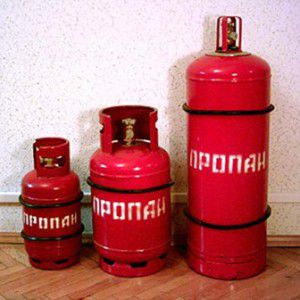
Often there are reviews that heating with liquefied gas allegedly requires huge cash costs. It is believed that the purchase of gas equipment, as well as the installation and maintenance of the system, are accompanied by excessive costs. But this does not always correspond to reality, and year after year, heating a private house with liquefied gas in cylinders is winning new adherents among the owners of summer cottages and cottages.
The advantages of LPG
- Possibility to arrange autonomous heating on liquefied gas away from gas mains;
- Convenient transportation that does not require the construction of pipelines;
- Higher heat capacity of a propane-butane mixture as compared to natural gas;
- Ecological cleanliness of the fuel obtained during the extraction and refining of oil;
- Relatively low cost in terms of rising prices for other types of fuel.
Disadvantages of LPG
- The cost of delivering gas for heating private houses with liquefied gas in cylinders may increase when the household is located too far from the city;
- In frosty winter, when heating a private house with liquefied gas, the problem of freezing of the gas reducer arises;
- If you create a supply of fuel in a gas tank installed on your site, then during periods of snow drifts there are difficulties with the passage of a refueling car to the house;
- The design and installation of autonomous heating on liquefied gas is allowed to be carried out only with the involvement of specialists from authorized organizations. And only the least critical elements of a liquefied gas heating system can be made by hand.
Features of heating with liquefied gas
The owner of a liquefied gas heating system is forced to monitor whether the tank connected to the boiler runs out of fuel. Some will consider this feature an inconvenience, but such a heating system can be autonomous and not depend on problems with the central gas supply. It is only necessary to regularly replace gas cylinders or immediately pump a sufficient amount of gas into the underground storage.
The use of gas cylinders in heating
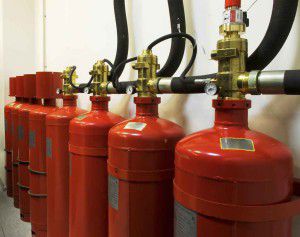
The option of heating a house with liquefied gas in 50-liter cylinders is the best fit for country houses and small cottages. So that you do not have to disconnect an empty cylinder every two days and connect a full one in its place, you can combine several cylinders at once into a battery. For this purpose, GOK fittings are used.If the homeowner installs the heating on liquefied gas with his own hands, he has the right to install a battery of no more than 3 cylinders without a project. More of them will require a project.
Install gas cylinders not indoors, but in a metal cabinet on the outside of the house. In winter, there are frequent cases of a decrease in the gas supply through the reducer due to the fact that the condensate contained in the cylinders partially freezes.
To prevent gearboxes from freezing at low temperatures, a small electric heater can be installed in the cylinder cabinet.
Gas holder for home heating
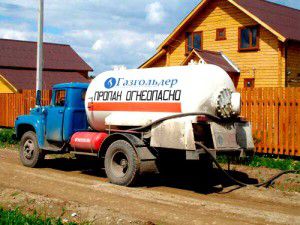
It is convenient to use cylinders when the gas consumption is not too high, and their delivery service operates smoothly. In other cases, it would be more rational to purchase and install a gas tank - a large underground storage tank for LPG, which will have to be filled with gas only 2-3 times a year. The volume of the gas tank can be from 3 to 10 cubic meters, it is selected in accordance with the capacity of the heating system.
An underground gas tank is allowed to be placed no closer than 10 m from a residential building, and from the side of the road it must be accessible for a refueling vehicle.
Calculation of costs for the device of autonomous gas heating
Comparing which of the types of heating systems will be the least expensive, you first need to pay attention to the consumption of liquefied gas for heating. It is advisable to compare the upcoming costs with similar costs for other fuels and decide which option will be more profitable.
Initial costs for equipment and furnishings
The cost of purchasing equipment and installing an autonomous heating system on liquefied gas in your home may vary slightly in different regions of residence. But in general, when compared with the connection to the main gas pipeline, the difference in cost will be insignificant. It will be more expensive only if you use not cylinders, but a gas holder with a volume of several cubes. Its cost will be more than 300,000 rubles.
Also, the cost of equipping rooms for boilers using LPG is almost equal in cost compared to those that run on diesel fuel. As evidenced by reviews, heating with liquefied gas only requires higher initial costs when it serves as an alternative to solid fuel or electric heating. But in the course of further operation, the funds invested in heating a private house with liquefied gas will gradually pay off due to the profitability of this type of fuel.
Gas consumption but heating of a private house
A few years ago, a propane-butane mixture was much more expensive than main gas (methane), but over time, the price difference between them decreases. Therefore, the relative indicators of the cost and consumption of liquefied gas for heating demonstrate the feasibility of using this energy carrier.
| Type of fuel | Specific heat of combustion, mJ | Retail cost of fuel, rub. | Cost of kW / h of energy, rub. |
| Propane-butane mixture (LPG) | 45–47 | 20-24 (for 1 kg) | 1,7–2,0 |
| Natural gas | 32–40 | 5.2-5.6 (per 1 m³) | 0,6–0,9 |
| Diesel fuel | 40–42 | 23-27 (for 1 liter) | 2,6–2,8 |
| Electricity | — | — | 3,5–3,8 |
The simplest way to determine the real consumption of liquefied gas for heating a house is to correlate the mass of gas in one cylinder with the technological characteristics of heating equipment. In this case, it is more convenient to calculate the flow rate by weight, since the volume (in liters) depends on the density and percentage of the propane-butane mixture pumped into the cylinder.
A standard 50-liter cylinder can be filled with 35-40 liters of LPG, which, in terms of weight, gives an average of 22 kg of gas.
Let's analyze a specific example to determine the required amount of liquefied gas in cylinders for heating a house with an area of 100 m²:
- Heating the specified area will require (according to the maximum rates) 10 kW of heat energy;
- However, the boiler does not operate constantly in maximum mode, and its average load factor can be taken as 0.5. This means that we need 5 kW;
- With the calorific value of liquefied gas of 46 mJ / kg, about 0.1 kg of LPG per hour will be consumed for the production of 1 kW of heat energy, and 0.5 kg of LPG will be required for 5 kW;
- 12 kg will be consumed per day, or almost half of the cylinder;
- The monthly consumption of liquefied gas for continuous heating of the house will be approximately 13-15 cylinders.
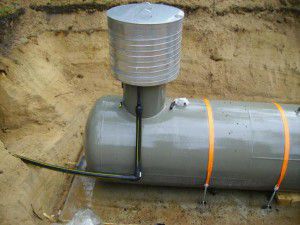
What will the consumption be if you do not use cylinders, but pump fuel into a gas tank? How often will you have to call a gas station to replenish the gas supply in the most common "five-cubic" tank among consumers? Let's figure it out:
- Any of the containers for liquefied gas is not filled "to the neck", but only by 80–85%. Accordingly, a tank with a volume of 5 m³ will contain about 4250 liters or (in terms of mass) 2300 kg of gas;
- We have already determined that in our case, the heating system on liquefied gas consumes 0.5 kg of fuel per hour;
- We divide the total mass of 2300 kg of gas contained in the gasholder by 0.5 kg / hour, and we get 4600 hours - for such a time, we have enough fuel supply;
- Dividing 4600 hours by 24 gives a total of 190 days. That is, one filling of a 5 m³ gas tank is enough to heat a 100 m² house for almost the entire heating season (in a temperate climate).
These are theoretical calculations, but in reality, fuel consumption can be significantly reduced. With the correct setting of the combustion modes, a gas heating boiler for liquefied gas can consume 1.5–2 times less fuel, and the temperature in the house will be maintained at an acceptable level.
To reduce the amount of gas combusted, use the automation, which at night switches the boiler to a moderate mode, reducing the temperature in the system by 7-9 degrees, thereby achieving cost savings by 30%.
Heating equipment for heating with liquefied gas
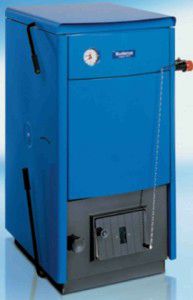
For heating a private house on liquefied gas, both heating boilers with a water circuit and gas convectors are used. But among all types of such equipment, liquefied gas heating boilers are still in the lead, as the most productive. Reviews of heating with liquefied gas using convectors are rarely positive.
Gas heating boilers for liquefied gas in their design almost do not differ from those that consume main gas. The only difference is in the design of the burners, since the pressure of propane-butane coming from the cylinder is almost 2 times higher than that of natural methane. Accordingly, the nozzles in the burners also differ in their inner diameter. There are also some differences in the devices for regulating the air supply.
Gas heating boilers for liquefied gas in their design almost do not differ from those that consume main gas. The only difference is in the design of the burners, since the pressure of propane-butane coming from the cylinder is almost 2 times higher than that of natural methane. Accordingly, the nozzles in the burners also differ in their inner diameter. There are also some differences in the devices for regulating the air supply.
The design differences are so insignificant that, if necessary, it is sufficient only to replace the burners in the boiler intended for methane, and there is no need to buy a new heating boiler for liquefied gas.
Let's consider how the main models of boilers for a liquefied gas heating system differ:
- Boiler type... Among the units for heating a private house with liquefied gas in cylinders, single-circuit and double-circuit boilers are distinguished. The former serve only for the heating system, while the latter, in addition, provide hot water.The combustion chamber in boilers is arranged in different ways; it can be open or closed. Both large floor-standing models and compact wall-mounted ones are available;
- Efficiency... Judging by the reviews, heating with liquefied gas can become truly rational and economical if the gas boiler has an efficiency of at least 90-94%;
- Boiler power... It is considered one of the main parameters when heating a private house with liquefied gas. It is necessary to make sure that the passport characteristics of the unit will allow it to develop sufficient power to provide the entire area of the dwelling with heat, but at the same time avoiding excessive consumption of liquefied gas for heating;
- Manufacturer... While piping in a liquefied gas heating system can be done by hand, a gas boiler should in no case be homemade. Moreover, it is advisable to give preference to well-established domestic or foreign manufacturers.
It is forbidden to install boilers for liquefied gas in basements, since the propane-butane mixture is heavier than air. In the event of leaks, such gas is not eroded, but accumulates at the floor level, which can lead to an explosion.
Gas heating system maintenance
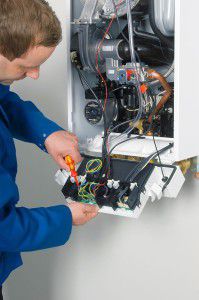
The heating system of a private house on liquefied gas requires periodic monitoring and maintenance. The trouble is, if in the middle of winter the boiler suddenly stops functioning normally! Causes of malfunctions of gas heating boilers for liquefied gas
are mainly associated with clogging of the burner or fuel filter. It is advisable to detect all faults in advance, and an experienced specialist should search for them.
The technician should check the condition of the liquefied gas heating boiler 1-2 times a year and carry out maintenance with the same regularity. The list of works is reduced to the inspection of burners and the combustion chamber, cleaning from soot and soot, checking the automation, adjusting the equipment.
It is not recommended to clean the burner yourself with a wire brush or clean the nozzle hole with a wire, as this will disturb its calibration.
The video will demonstrate what a worthy alternative to natural gas can be liquefied petroleum gas (LPG).
In conclusion, we can add that many users are campaigning for heating with liquefied gas, their reviews testify to the effectiveness of the autonomous system. Even in spite of the hassle associated with the periodic replacement of gas cylinders.







